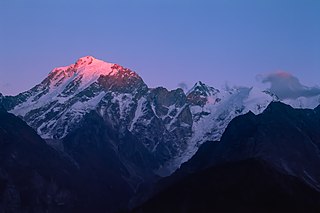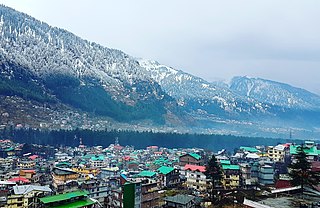
Himachal Pradesh is a state in the northern part of India. Situated in the Western Himalayas, it is one of the thirteen mountain states and is characterised by an extreme landscape featuring several peaks and extensive river systems. Himachal Pradesh is the northernmost state of India and shares borders with the union territories of Jammu and Kashmir and Ladakh to the north, and the states of Punjab to the west, Haryana to the southwest, Uttarakhand to the southeast and a very narrow border with Uttar Pradesh to the south. The state also shares an international border to the east with the Tibet Autonomous Region in China. Himachal Pradesh is also known as Dev Bhoomi, meaning 'Land of Gods' and Veer Bhoomi which means 'Land of the Brave'.

Shimla is the capital and the largest city of the northern Indian state of Himachal Pradesh. In 1864, Shimla was declared the summer capital of British India. After independence, the city became the capital of East Punjab and was later made the capital city of Himachal Pradesh. It is the principal commercial, cultural and educational centre of the state.

Solan is a city in the Indian state of Himachal Pradesh and the district headquarters of Solan district. It is located 45.5 kilometres (28 mi) south of the state capital, Shimla. Solan has an average elevation of 1,550 metres (5,090 ft). The city is situated between Chandigarh and Shimla on the Kalka-Shimla National Highway-5. The narrow-gauge Kalka-Shimla railway passes through Solan. Located on the Punjab-Himachal Border, Solan is nestled in the Shivalik hills of the Himalayas.

Kullu is a district in Himachal Pradesh, India. It borders Shimla district to the south, Mandi and Kangra districts to the west, Kinnaur to the east and the Lahaul and Spiti district to the north and east. The largest valley in this mountainous district is the Kullu Valley. The Kullu valley follows the course of the Beas River, and ranges from an elevation of 833 m above sea level at Aut to 3330 m above sea level at the Atal Tunnel South Portal, below the Rohtang Pass. The town of Kullu, located on the right side of the Beas River, serves as the administrative headquarters of the Kullu district. The Kullu district also incorporates several riverine tributary valleys of the Beas, including those of the Parvati, Sainj, and Tirthan rivers, and thus some regions somewhat distant from the Kullu valley. The economy of the district relies mainly on horticulture, agriculture, tourism, and traditional handicrafts.

Manali is a resort town, near Kullu town in Kullu district in the Indian state of Himachal Pradesh. It is situated in the northern end of the Kullu Valley, formed by the Beas River. The town is located in the Kullu district, approximately 270 kilometres (170 mi) north of the state capital of Shimla and 544 kilometres (338 mi) northeast of the national capital of New Delhi. With a population of 8,096 people recorded in the 2011 Indian census Manali is the beginning of an ancient trade route through Lahaul (H.P.) and Ladakh, over the Karakoram Pass and onto Yarkand and Hotan in the Tarim Basin of China. Manali is a popular tourist destination in India and serves as the gateway to the Lahaul and Spiti district as well as the city of Leh in Ladakh.

Kinnaur district is one of the twelve administrative districts of the state of Himachal Pradesh in northern India. The district is divided into three administrative areas and has six tehsils. The administrative headquarters of the district is at Reckong Peo. The revered Kinnaur Kailash mountain, one of the Panch Kailash sites, is situated in Kinnaur. As of 2011, it is the second least populous district of Himachal Pradesh, after Lahaul and Spiti.

Vaisakhi, also known as Baisakhi, marks the first day of the month of Vaisakh and is traditionally celebrated annually on 13 April and sometimes 14 April. It is seen as a spring harvest celebration primarily in Punjab and Northern India. Whilst it is culturally significant as a festival of harvest, in many parts of India, Vaisakhi is also the date for the Indian Solar New Year.
Palampur is a hill station and a municipal corporation situated in the Kangra District in the Indian state of Himachal Pradesh.

The Ridge road is a large open space, located in the center of Shimla, the capital city of Himachal Pradesh, India. The Ridge is the hub of all cultural activities of Shimla. It is situated along the Mall Road, which is the famous shopping center of Shimla. Most major places of Shimla like Sanjauli Snowdown (IGMC), Mall Road, Jakhu Temple, Oakover, Kali Bari, Annadale, etc. are connected through the Ridge.

Chamba is a town in the Chamba district in the Indian state of Himachal Pradesh. According to the 2001 Indian census, Chamba has a population of 20,312 people. Located at an altitude of 1,006 metres (3,301 ft) above mean sea level, the town is situated on the banks of the Ravi River, at its confluence with the Sal River.
The North Indian state of Himachal Pradesh is a state that has remained largely uninfluenced by Western culture. Himachal Pradesh is a multi-religion practising, multicultural and multilingual state. Some of the most commonly spoken languages are Hindi and the various Pahari languages. The Hindu communities residing in Himachal include the Brahmins, Rajputs, Kannets, Rathis and Kolis. There is also a tribal population in the state which mainly comprises Gaddis, Kinnarms, Gujjars, Pangawals and Lahaulis.

Spiti is a high-altitude region of the Himalayas, located in the north-eastern part of the northern Indian state of Himachal Pradesh. The name "Spiti" means "The middle land", i.e. the land between Tibet and India. Spiti incorporates mainly the valley of the Spiti River, and the valleys of several rivers that feed into the Spiti River. Some of the prominent side-valleys in Spiti are the Pin valley and the Lingti valley. Spiti is bordered on the east by Tibet, on the north by Ladakh, on the west and southwest by Lahaul, on the south by Kullu, and on the southeast by Kinnaur. Spiti has a cold desert environment. The valley and its surrounding regions are among the least populated regions of India. The Bhoti-speaking local population follows Tibetan Buddhism.

Kaza, also spelled Kaze, Karze, Karzey, is a town and the subdivisional headquarters of the remote Spiti Valley in the western Himalayas in the Lahaul and Spiti district of the northern Indian state of Himachal Pradesh. Spiti is a high altitude or cold desert having close similarities to the neighbouring Tibet and Ladakh regions in terms of terrain, climate and the Buddhist culture. Kaza, situated along the Spiti River at an elevation of 3,650 m (11,980 ft) above mean sea level, is the largest township and commercial center of the Spiti valley.

Vijay Sharma is an Indian painter and art historian, known for his expertise in the Pahari school of miniature painting. He was honored by the Government of India, in 2012, with the fourth highest Indian civilian award of Padma Shri.

Tourism in Himachal Pradesh relates to tourism in the Indian state of Himachal Pradesh. This is popularly renowned for its Himalayan landscapes and popular hill-stations. Many outdoor activities such as rock climbing, mountain biking, paragliding, ice-skating, trekking, rafting, and heli-skiing are popular tourist attractions in Himachal Pradesh.

Annadale, also spelled as Annandale is a locality of Shimla city, in the Indian state of Himachal Pradesh. It is a flat valley bottom which includes the helipad as well as a golf course in the city. Annadale has also an army cantonment with an Army Heritage Museum. Due to its lush green environment, historical importance and first seen place by every VVIP visit, it is also known as the "Heart of Shimla".

Chandra Haas Bhasin, better known by his pen-name Raaja Bhasin, is a writer, historian, public speaker, and curator from Himachal Pradesh, India. He is noted as an authority on the cultural and architectural history of colonial-era Shimla, the erstwhile summer capital of the British Raj and the present-day capital of the Himachal Pradesh state. Bhasin is particularly known for his book Simla: the Summer Capital of British India, first published in 1992. He has appeared as an expert on Shimla in several popular travel and historical documentaries, including ones made by William Dalrymple, Michael Palin, Gurinder Chaddha, and Anthony Bourdain. Bhasin is also regarded as an expert on various aspects of Himachal Pradesh, including tourism and cultural heritage - also subjects on which he has written and lectured extensively.
Mian Goverdhan Singh was a writer and librarian from Himachal Pradesh, India. He is noted for his books on the history, cultural traditions, and historic architectures of Himachal Pradesh. He is also known for having facilitated the research for a number of well-known books, both during and after his tenure as librarian at the State Secretariat Library in Shimla, Himachal Pradesh.

Minjar Mela, also known as the Minjar Fair, is a popular annual festival celebrated in the state of Himachal Pradesh in India. It has been granted the status of international fair by govt of Himachal Pradesh. The fair is held in the town of Chamba, which is located in the scenic Chamba Valley. Minjar Mela is a week-long event that typically takes place in the month of July. The festival holds great cultural and historical significance for the people of Chamba. It is celebrated to mark the harvesting of the maize crop and to seek blessings for a bountiful year ahead. The highlight of Minjar Mela is the Minjar procession, which is a grand and colorful event. The procession is led by a decorated chariot, accompanied by folk dancers, musicians, and devotees dressed in traditional attire. People from nearby villages and towns join the procession, adding to the festive atmosphere.

Suket Fair is an annual Indian state-level fair held in Sundar Nagar, Himachal Pradesh during the Hindu festival Chaitra Navratri. According to the local people, it is also known by the names Suket Devta Mela and Sundernagar Mela, among others.

















